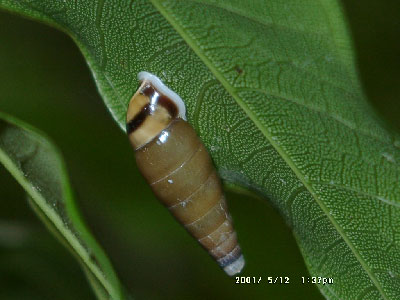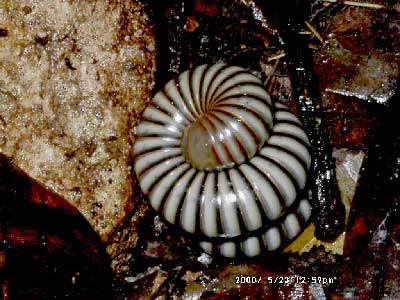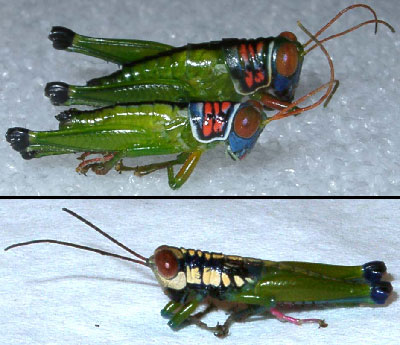Biotic Survey of Jamaican Mollusks and other Terrestrial Invertebrates
By Gary Rosenberg. Posted May 2003; updated 29 December 2004 and 5 August 2005
Between 1999 and 2002, seven expeditions of three to four weeks each were conducted in Jamaica, to collect land snails, millipedes, and other invertebrates with low dispersal ability. This work was funded by National Science Foundation Grant DEB-9870233. We sampled intensively at 607 sites throughout the island, concentrating on mollusks and millipedes, but also collecting arthropods of all sorts and earthworms.
Diversity of mollusks
Jamaica has one of the world's most diverse faunas of terrestrial mollusks. Several workers have reported that Jamaica has more than 400 species, but the only comprehensive list prior to the one presented here was published by Vendryes (1899), who listed 533 species. As a result of our field work, studies of museum collections and the literature on Jamaica, we have determined that there are 561 named species of terrestrial mollusks in Jamaica. Of these, 505 are endemic to Jamaica, that is, found nowhere else in the world. This is an extraordinary level of diversity for an island of only 11,500 square kilometers (about the size of Connecticut and smaller than Israel). For comparison, the United States east of the Mississippi River has only 431 native species of snails and slugs, in an area 170 times larger.
This site lists the terrestrial mollusks of Jamaica and presents a key for identifying most of the land snail species. Other topics briefly treated herein are undescribed, newly described and introduced species in Jamaica.
Mollusk species list Key Instructions for Key Diversity by family Gallery of images

Anoma levis (C. B. Adams, 1851),Westmoreland, Jamaica
|
Retreating fauna
Although less than 15% of the original forest cover of Jamaica still
exists, perhaps as much as 90% of the mollusk fauna is extant, although
some species have suffered great contractions of range. Many species survive
in areas of secondary forest.
Tree snails of the genus Anoma (Urocoptidae) are the most critically
endangered and it is likely that some are already extinct. Fewer than a
dozen specimens of Anoma were found alive, representing three of
the twenty known species. Many Jamaican species have naturally small geographic
ranges, so even with intensive sampling it is difficult to establish that
a species is no longer extant, especially if the type locality was no more
precise than 'Jamaica'. A few endemic species, particularly those adapted
to dry conditions, are expanding their ranges.
|
Undescribed species
More than one hundred undescribed species were collected, including snails, millipedes, grasshoppers, earthworms, crabs, dipluran insects, and isopods. About three dozen undescribed snail species have been identified to date, and more will surely come to light as we continue sorting microsnails from litter samples. The greatest number of undescribed species come from remote areas. For example, 9 out of 15 species of snails found on Blue Mountain Peak, the highest point in Jamaica, are undescribed. (Some of the punctid snails from high altitudes in Jamaica referred to of this page before 5 August 2005 are probably helicodiscids). Taking undescribed species into account, the total diversity of the Jamaican terrestrial fauna will likely exceed 600 species.
Some species named as a result of the surveys

|

|
A five inch long millipede in the Cockpit Country
of Jamaica. This is the first known specimen of Eurhinocricus rosenbergi
Bond & Sierwald, 2002, named in the Proceedings of the Biological
Society of Washington 115: 670-675.
|
Two species of grasshoppers from the Cockpit Country in Jamaica, Dellia karstica (top) and Dellia maroona
Perez-Gelabert, 2001, named in the Journal of Orthoptera Research
10: 75-80.
|
Introduced species of mollusks
Of the 561 species of snails known from Jamaica, 56 occur elsewhere. At least 25 of these species were introduced by humans, including seven snails discovered in Jamaica as a result of this research: Helicodiscus parallelus (Helicodiscidae),
Beckianum beckianum (Subulinidae), Bulimulus diaphanus and
Drymaeus multilineatus (Bulimulidae), Zachrysia provisoria (Camaenidae),
Huttonella bicolor (Streptaxidae), and Happiella decolorata (Systrophiidae). Records of Bradybaena similaris (Bradybaenidae) were not based on our surveys as stated on this page before 5 August 2005, but on records from USDA.
This material is based upon work supported by the
National Science Foundation under Grant No. 9870233. Any opinions, findings,
and conclusions or recommendations expressed in this material are those of
the author(s) and do not necessarily reflect the views of the National Science
Foundation
©2004 All Rights Reserved, The Academy of Natural Sciences, 1900 Benjamin Franklin
Parkway, Philadelphia, PA 19103
Tel: 215-299-1000 Email: rosenberg@ansp.org


